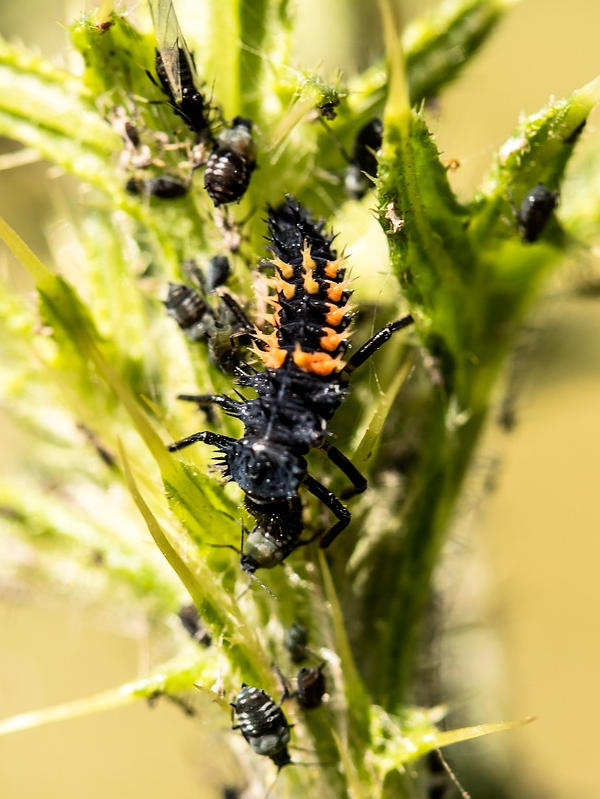
Eradicate Aphids from your Tomato Crop
I’ve found five well known ways to eradicate aphids. So far I’ve put two of them to the test.
First I’ve had some luck with spraying aphids off my tomato plants with nothing more than a blast of water.
The second method I’ve tried is sowing marigold seeds to provide beneficial companion plants in and around the tomato plants.
There are a few other well known aphid countermeasures that I haven’t tried. For example, you can also grow companion plants that attract aphid predators rather than repelling aphids. Alternatively, you can purchase beneficial predators and then release them directly into your garden.
Beyond companion plants and predators, there are two fast acting methods for eradicating aphids which I also have not yet tried. One is to spray the plants with a solution of insecticidal soap and oil in water, and another is to spray your plants with a solution neem oil and soap in water.
The best method may well be to let nature take its course.
Let’s go into a little more detail.
The Deadly Water Spray Method for Eradicating Aphids
This method works when the infestation is not too bad.
I’ve blasted multiple aphids into oblivion with a water jet. First I spotted a thumb sized patch of aphids on my young tomato plant’s stem, on just one of the plants. I armed myself with my Garden Water Wand by FlexiHose. I set it to “shower” mode. By turning its flow control dial, I gradually increased the flow rate until the force of the water jet was just strong enough to dislodge the aphids and wash them away without putting too much stress on the tomato stem. What also worked was to vary the angle of contact for the water jets hitting the plant and also to vary the distance between the nozzle and the plant, to find the best combination of water jet flow, angle and nozzle distance. Doing so worked well for blasting aphids off of tomato plant stems, because the stems are fairly rigid. Since then, I’ve checked back and have only seen single aphids here and there.
I’m not sure if this method can work on leaves, but luckily I haven’t found any aphids on the leaves of my tomato plants. In any case, you can certainly use the force of a water jet to dislodge and wash away the little blighters.
Noxious Companion Plants that Repel Aphids
Marigolds secrete biochemicals that repel aphids and other pests. It’s too soon to tell if this method is effective in my garden because the marigolds are quite small and haven’t yet bloomed. They’re dwarfed by the tomato plants. In any case, whether or not they repel aphids, I’m looking forward to seeing my marigolds bloom. Other companion plants that repel aphids include nasturtiums and chives.
Companion Plants that Attract Aphid Predators
The four predators you want to attract are ladybug larvae, lacewings, hoverfly larvae and parasitic wasps. David Spencer of the Full Circle Farm blog reports that buckwheat and alyssum attract parasitic wasps. ChatGTP tells me that dill and fennel attract ladybugs and lacewings. Admittedly, there is a time lag between when adult predators arrive in your garden, especially ladybugs, and when their far more voracious larvae set out to feast on aphids.
Aphid Suffocating Soap Solutions
I’m not sure how the soap kills the aphids but purportedly it’s selectively lethal to soft bodied bugs. Different sources describe different fates for the aphids – all quite grisly – from dissolving their exoskeletons to suffocating them, Oh my! In any case, the active ingredients at killing aphids are limited to the salts of fatty acids. In other words, fatty acid anions. So it makes sense to avoid using liquid soap that contains other ingredients that could harm your crop, you know, such as degreasers,antibacterial agents, perfumes, and the like.
Before listing the recipes of diy insecticidal soap solutions, I must state a few of caveats:
- The insecticidal soap may also wipe out soft bodied aphid predators – e.g. the larvae of hoverflies and ladybugs.
- The soap may remove the waxy coating on plant leaves, which may confuse or deter harmful predators (suggested by David Spencer of the Full Circle Farm blog).
- Soap and related surfactants may harm frogs and other amphibians. Be nice to frogs!
- Some garden plants, including your own tomato varieties, may be sensitive to soap, so always test a small area first.
- Hard water may inactivate the solution by forming insoluble complexes between Mg ions and the fatty acid salts.
diy Insecticidal Soap Recipes
Choose a liquid soap free from special additives, for example, Dr. Bronner’s Castile Soap. I prefer Dr. Bronner’s Eucalyptus Castile Soap. It’s what I shower with every day, so I have a lot on hand.
Also obtain a garden spray can. Avoid using hard water because the magnesium ions in hard water may inactivate the solution by forming insoluble complexes with the fatty acid anions.Only prepare the amount you immediately need because the shelf life of your solution may be quite short. Bob Vila suggests that you add vegetable oil in equal measure to the soap as a “surface agent” for keeping the soap from beading up or draining off the plants and aphids.
The average concentration I’ve found is 2 tablespoons (50 ml) in one gallon of water (4 liters). Consider adding 1 tablespoon of vegetable oil to the mix as well.
Bob Vila recommends 2-½ tablespoons of liquid soap and 2-½ tablespoons of vegetable oil, coconut oil or olive oil in one gallon of water.
Oil free mixtures are also reported online. The U of Arkansas recommends just one tablespoon of soap per gallon of water. https://ualr.edu/garden/2022/04/11/what-do-you-do-about-aphids/ ChatGRT – 4 tablespoons per gallon.
How much solution will you need? Enough to fully cover the entire aphid infestation on your plant. Or perhaps you’ll go crazy and want to spray your entire plant. Exact amounts depend on too many variables. How long is a piece of string? I’d guess that one gallon is good for nine plants, based on what the Geek recommends (see below). Don’t quote me. Just remember that the effectiveness of this spray is temporary, so it only makes sense to spray the aphid infestation directly, and not try to give your plants a protective coating.
Neem Oil Aphid Nemesis
The active ingredient of neem oil is azadirachtin, which is found in neem oil at a concentration of 0.2% to 0.8% by weight. I’ve read that this beast of a multicyclic ring molecule interrupts the life cycle and metamorphosis of several pests. I still don’t have a clear idea of how it actually works against aphids, except that azadirachtin is the neem tree’s self defense chemical against far nastier insects back in India where the neem tree grows.
Again, you’re going to need a garden spray can to apply this solution to your plants.
According to the Backyard Garden Geek, you can prepare a neem oil solution by adding 2 tablespoons of neem oil concentrate and 1 tablespoon of liquid soap to 1 gallon of water, good for up to 9 tomato plants.
One of the liquid soaps recommended by the Geek is Dr. Bronner’s Peppermint Oil Castile Soap. I’m sure Dr. Bronner’s Eucalyptus Castile Soap would work just as well.
The Geek recommends Bliss Pure Neem Oil ($24 per pint) and a few other vendors.
Now it occurred to me that this recipe is quite similar to the diy insecticidal soap recipe. A little soap. A little oil. A gallon of water. How can I say for sure whether the soap (fatty acid anions) or the neem oil (azadirachtin) is more effective at killing the aphids? I can’t. The other point is that the active ingredient, azadirachtin, breaks down quite rapidly, so like the diy insecticidal soap, it only makes sense to spray the actual aphid infestation, and not go for a prophylactic coating.
Deadly Aphid Assassin Bugs
David Spencer points out the controversy surrounding ladybugs and recommends against using them. He recommends responsibly sourced ladybug larvae in addition to hoverfly larvae and lacewings (as eggs) as far more effective aphid predators. I highly recommend you check out his blog. Interestingly, he seems to favor attracting natural predators to your garden. Hear! Hear!
Final Method – Do Nothing
Tomato plants are pretty tough and can fend for themselves. It may make more sense to leave them be, if the aphid situation is not too severe. A light infestation may be all it takes to attract beneficial predators. Good news for the predators. Bad news for the aphids. Problem solved.
